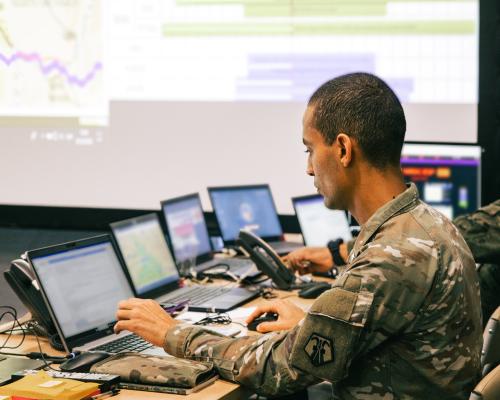Artificial intelligence (AI) has surged into the economy as a “general purpose” technology with revolutionary implications. Big Tech is piling on, data centers are being announced weekly, and tech seers of all stripes are certain AI will deliver unprecedented productivity gains for people, firms, and places. And maybe it will.
However, AI’s diffusion into the economy may not prove as wide-ranging as imagined. For one, the technology’s impact depends on what tech expert Nicolas Colin says is the effectiveness with which different industry sectors turn AI efficiency into “lasting productivity and economic growth.” Some firms and industries will do this well, and others won’t.
But starker forms of unevenness may be forthcoming: namely, the geographic unevenness of AI readiness.
This summer, Brookings research revealed the emergence of a pronounced “winner-take-most” divide in the nation’s AI adoption, with a short list of metro areas holding outsized dominance on measures of AI readiness. Thirty of these metro areas now account for two-thirds of all the nation’s AI-related job postings.
Similarly, in September, AI giant Anthropic reported striking variations in how and where consumers are using its AI chatbot Claude. The company found per capita usage differences not just among countries but also among states: from 3.82 times more than expected in Washington, D.C., to 0.21 times less than expected in Mississippi (expected usage is based on the state’s population).
In these early days, then, AI readiness looks patchy and highly uneven. Specifically, AI readiness in the U.S. seems to be concentrating in a short list of places endowed with abundant digital talent pools, key elements of the university-compute-innovation stack, and solid business adoption of cloud, data, and AI tools.
This begs a question: Do such gaps matter? Isn’t AI unevenness just a natural part of the early phase of development—and even valuable?
To an extent, unevenness is expected at this point. New technologies frequently begin their development in geographically concentrated locations (think Silicon Valley). Technologies then mature and their hiring diffuses, ensuring that they often spread out across the map, as economists Aakash Kalyani, Nicholas Bloom, Marcela Carvalho, Tarek Hassan, Josh Lerner, and Ahmed Tahoun have documented.
Yet this process of diffusion is extremely slow, observe Kalyani and colleagues. They assess that a novel technology like AI can take around 50 years to fully disperse. And they show that even then, the pioneering locations remain the focus for that technology’s highest-skill jobs for decades. In other words, most places never truly “catch up.”
All of which points to why the extreme geographic concentration of AI readiness may be something to worry about. Such gaps and deficits may result in unrealized opportunities for productivity growth across disparate industries, and limit discovery and dissemination of the full range of AI use cases. For that matter, disparities in AI readiness may leave some communities to fall behind or slump into “development traps.”
In that sense, imbalances in AI talent, innovation infrastructure, and business adoption very well could decide which people and places will prosper in the future—and which will not. Sharpening that worry is the fact that early patterns of tech development have a long-standing tendency to lock in “path dependencies,” as pioneering places gain advantages that soon become impregnable.
Given all of this, Brookings’ AI readiness maps—which highlight the 30 or so “star” metro areas and hundreds of others with more modest toeholds—suggest the nation should both celebrate emerging AI adoption and get serious about countering its wide divides. Lagging regions entail lost opportunities for local and aggregate progress, as we wrote this summer. For that reason, it behooves the nation and its states to work together to widen the reach of AI development.
Individual regions will want to engage in urgent “self-help,” starting now, to improve their AI readiness (our earlier report provides some strategies). Beyond that, the nation as a whole urgently needs to build out a strong AI readiness platform to support regions and try to counter extreme geographic divides.
The earlier agenda sketches a reasonable set of national AI readiness strategies focused on empowering regional AI clusters across talent, innovation infrastructure, and business adoption pillars. This agenda might entail funding AI curriculum development at higher education institutions; prioritizing a step change in total R&D AI outlays while promoting local tech benefits from data centers; and leveraging the nation’s experience with place-based industrial development to accelerate AI adoption in promising business clusters and sectors across the country.
Investment in some of these priorities by the Trump administration would do a lot to geographically balance the nation’s AI development. So would implementation of a few items in the administration’s AI Action Plan—namely, those focused on talent and workforce, basic and applied AI research, and national AI Centers of Excellence where researchers, startups, and established firms would be able to deploy and test AI tools while sharing data and results. Unfortunately, though, many of the Action Plan’s valuable items remain bogged down by staff cuts and furloughs.
Looking ahead, maximizing AI’s economic impact is going to depend heavily on countering regional gaps that might not narrow on their own. Only through sustained, regionally conscious action can the nation shape a future in which AI’s transformative potential benefits people and places everywhere.
The Brookings Institution is committed to quality, independence, and impact.
We are supported by a diverse array of funders. In line with our values and policies, each Brookings publication represents the sole views of its author(s).





